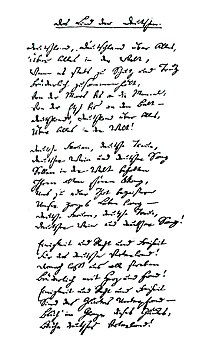
Back Deutschlandlied Afrikaans Deutschlandlied ALS Lied der Deutschen AN أغنية الألمان Arabic اغنية الالمان ARZ Lied der Deutschen AST Almaniya himni Azerbaijani Песня немцаў Byelorussian Гімн Нямеччыны BE-X-OLD Химн на Германия Bulgarian
| English: 'Germany Song' | |
|---|---|
 Facsimile of Hoffmann von Fallersleben's manuscript of "Das Lied der Deutschen" | |
National anthem of Germany | |
| Also known as | "Das Lied der Deutschen" (English: 'The Song of the Germans') |
| Lyrics | August Heinrich Hoffmann von Fallersleben, 1841 |
| Music | Joseph Haydn, 1797 |
| Adopted | 11 August 1922 |
| Readopted | 2 May 1952 |
| Relinquished | 1945 |
| Preceded by |
|
| Audio sample | |
Instrumental rendition by the United States Army Europe Band and Chorus in E-flat major | |
The "Deutschlandlied",[a] officially titled "Das Lied der Deutschen",[b] is the national anthem of Germany. It was first adopted in 1922 during the period of the Weimar Republic, replacing "Heil dir im Siegerkranz". The first stanza of "Deutschlandlied" was used alongside the "Horst-Wessel-Lied" during the Nazi regime from 1933 until the end of World War II. Since then, only the third stanza has been used officially as the national anthem.
Its phrase "Einigkeit und Recht und Freiheit" ('Unity and Justice and Freedom') is considered the unofficial national motto of Germany,[1] and is inscribed on modern German Army belt buckles and the rims of some German coins.
The music is derived from that of "Gott erhalte Franz den Kaiser", composed in 1797 by the Austrian composer Joseph Haydn as an anthem for the birthday of Francis II, Emperor of the Holy Roman Empire and later of Austria. In 1841, the German linguist and poet August Heinrich Hoffmann von Fallersleben wrote the lyrics of "Das Lied der Deutschen" as a new text for that music, counterposing the national unification of Germany to the eulogy of a monarch: lyrics that were considered revolutionary at the time.
The "Deutschlandlied" was adopted as the national anthem of Germany in 1922, during the Weimar Republic, to which all three stanzas were used. West Germany retained it as its official national anthem in 1952, with only the third stanza sung on official occasions. After German reunification in 1990, in 1991 only the third stanza was reconfirmed as the national anthem. It is discouraged, although not illegal, to perform the first stanza (or to some degree, the second), due to association with the Nazi regime.
Cite error: There are <ref group=lower-alpha> tags or {{efn}} templates on this page, but the references will not show without a {{reflist|group=lower-alpha}} template or {{notelist}} template (see the help page).
- ^ Minahan, James (6 March 2010). The Complete Guide to National Symbols and Emblems. Greenwood Press. ISBN 978-0-313-34498-5 – via Google Books.